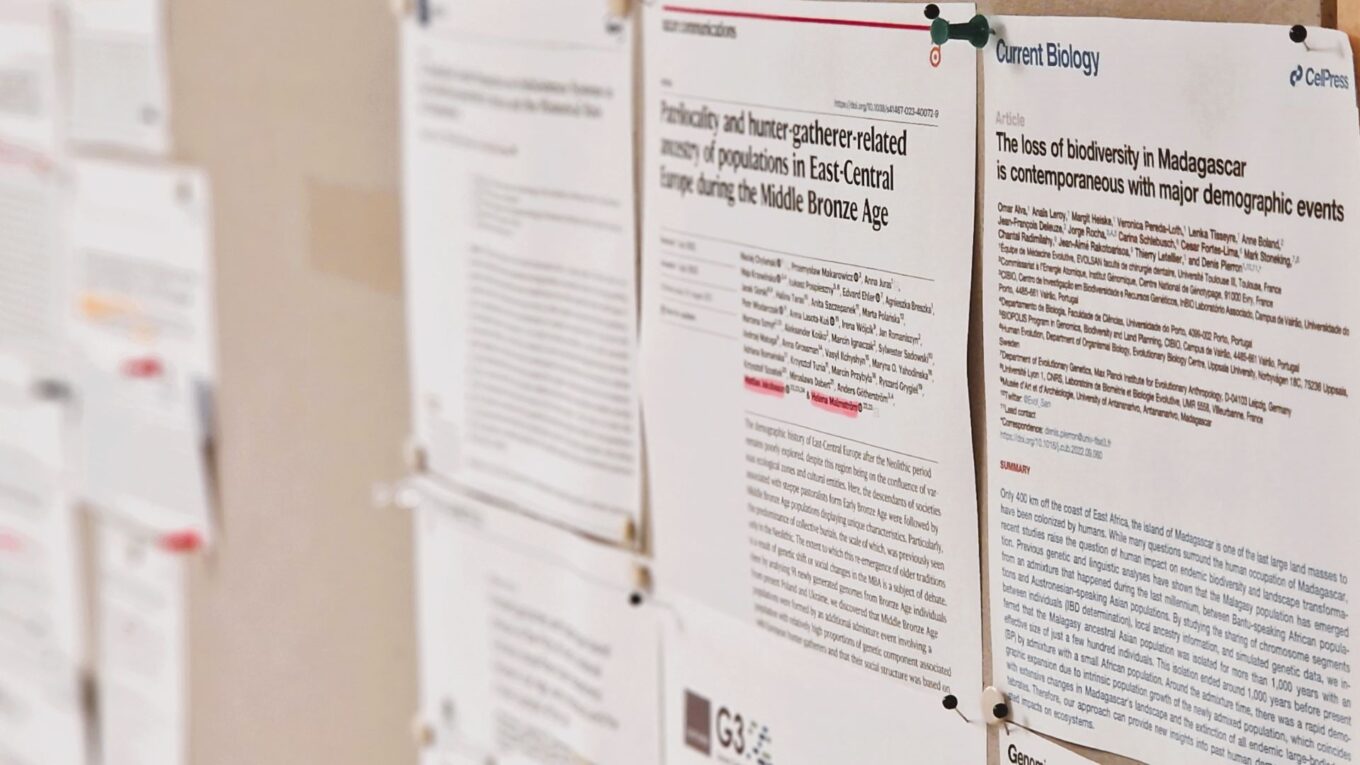
The latest articles
- by Gwenna BretonSub-equatorial Africa is today inhabited predominantly by Bantu-speaking groups of Western African descent who brought agriculture to the Luangwa valley in eastern Zambia similar to 2000 years ago. Before their arrival the area was inhabited by hunter-gatherers, who in many cases were subsequently replaced, displaced or assimilated. In Zambia, we know little about the genetic […]
- by Isabel AlvesThe demographical history of France remains largely understudied despite its central role toward understanding modern population structure across Western Europe. Here, by exploring publicly available Europe-wide genotype datasets together with the genomes of 3234 present-day and six newly sequenced medieval individuals from Northern France, we found extensive fine-scale population structure across Brittany and the downstream […]
- by Hugo ZebergModern human ancestors diverged from the ancestors of Neandertals and Denisovans about 600,000 years ago. Until about 40,000 years ago, these three groups existed in parallel, occasionally met, and exchanged genes. A critical question is why modern humans, and not the other two groups, survived, became numerous, and developed complex cultures. Here, we discuss genetic […]
- by Nora BergfeldtWith the Neolithic transition, human lifestyle shifted from hunting and gathering to farming. This change altered subsistence patterns, cultural expression, and population structures as shown by the archaeological/zooarchaeological record, as well as by stable isotope and ancient DNA data. Here, we used metagenomic data to analyse if the transitions also impacted the microbiome composition in […]
- Metagenomic analysis of Mesolithic chewed pitch reveals poor oral health among stone age individualsby Emrah KirdökPrehistoric chewed pitch has proven to be a useful source of ancient DNA, both from humans and their microbiomes. Here we present the metagenomic analysis of three pieces of chewed pitch from Huseby Klev, Sweden, that were dated to 9,890-9,540 before present. The metagenomic profile exposes a Mesolithic oral microbiome that includes opportunistic oral pathogens. […]
- by Luciana G. SimõesSince the early Holocene, western and central Europe was inhabited by a genetically distinct group of Western Hunter-Gatherers (WHGs). This group was eventually replaced and assimilated by the incoming Neolithic farmers. The western Atlantic façade was home to some of the last Mesolithic sites of mainland Europe, represented by the iconic open-air sites at Hoedic […]
More publications from Jakobsson Lab


Prepress articles
- by Natalija Kashuba
- The genomic history of the Iberian hunter-gatherers, from the Late Pleistocene to the Early Holoceneby Rita Peyroteo Stjerna
- by James McKenna
- by Gwenna BretonHuman evolutionary history in Africa before and after the out-of-Africa event remains largely unexplored, due to lack of genome sequence data, limited representation of populations and limitations of presently available inference methods. We generated high-coverage genomes from 49 Central African individuals, from five rainforest hunter-gatherer populations and four neighboring populations, and from 25 Khoe-San individuals, […]
- by Alexandra CoutinhoSeveral well-known genetic variants that confer disease resistance or other adaptive advantages have been investigated in modern-day populations across the globe. In particular, sub-Saharan African populations display variation for many of these loci. In this study, we investigate allele frequencies underlying functional variants of interest in sub-Saharan African populations. By also investigating sequence data from […]
- by Thijessen Naidoo
- by Thijessen Naidoo
- by Thijessen Naidoo
- by Magdalena Fraser
- by Nina Hollfelder
- by Sjöstrand Agnès E.
- by Sjöstrand Agnès E.
- by Lucie Gattepaille
- by Lucie Gattepaille
- by Oddný Ósk Sverrisdóttir
- by Evangelia Daskalaki
- by Pontus SkoglundRecent ancient DNA studies have provided new evidence for prehistoric population structure associated with the contentious transition to an agricultural lifestyle in Europe. In this study, we infer human population structure and history in Holocene Europe by generating ancient genomic sequence data from 9 Scandinavian individuals associated with the foraging Pitted Ware Culture and the […]
- Genome-wide distribution of the Time to the Most Recent Common Ancestor in various human populationsby Sen Li
- by Sen Li
- by Veronica Nyström
